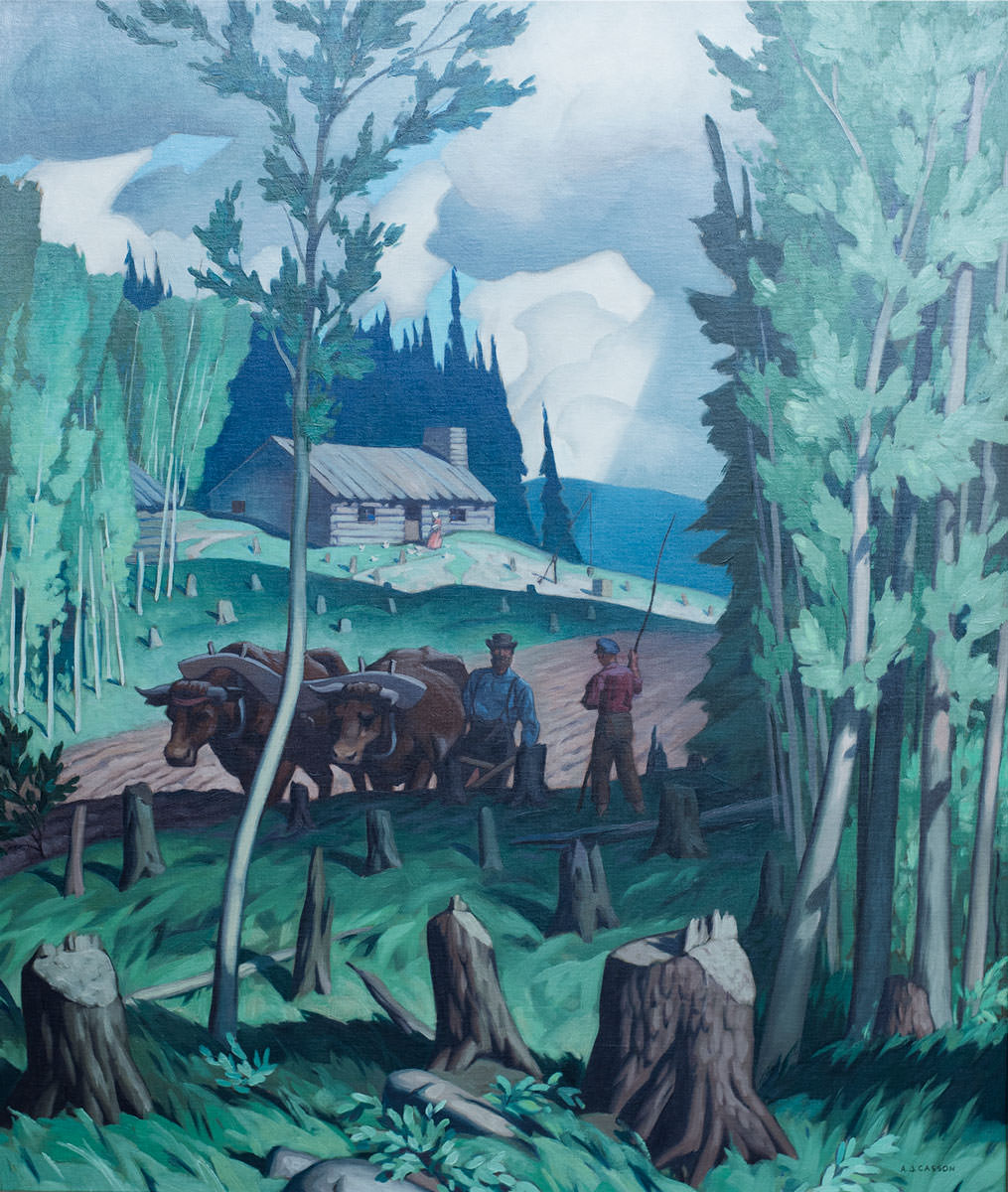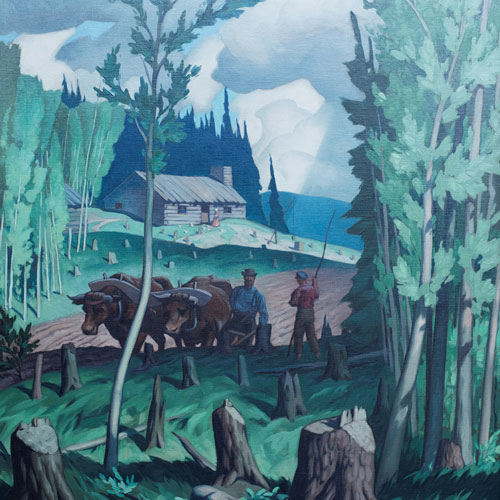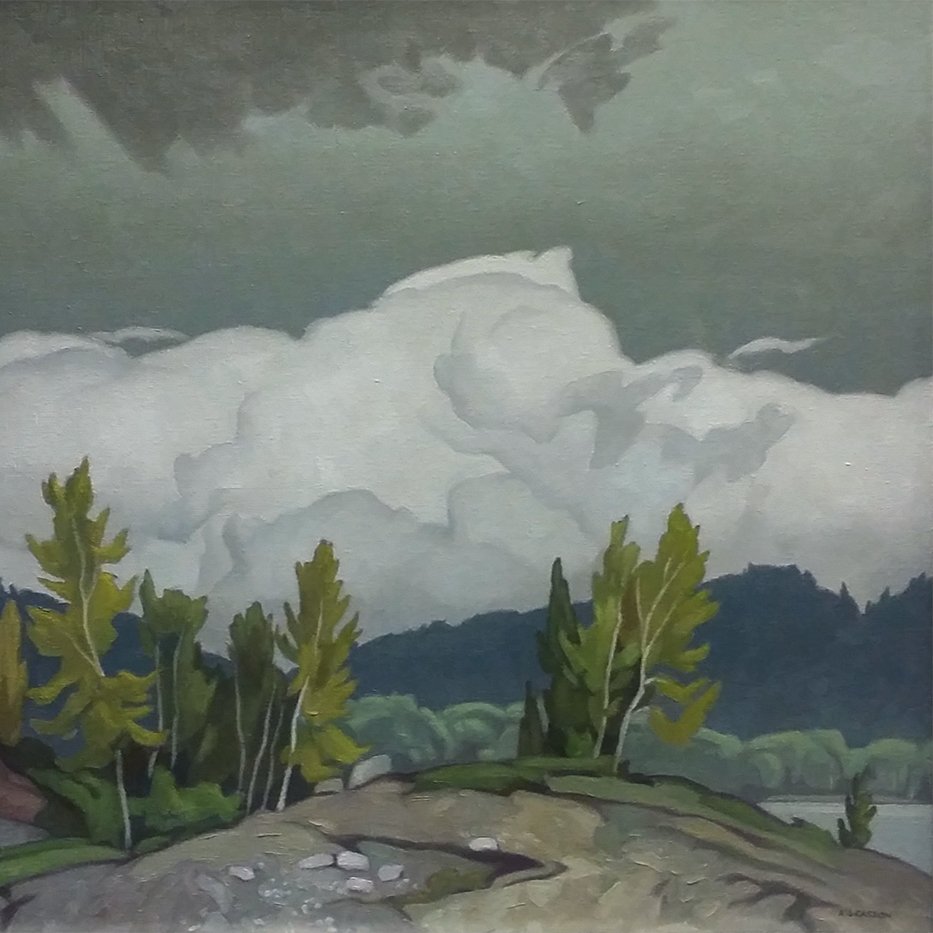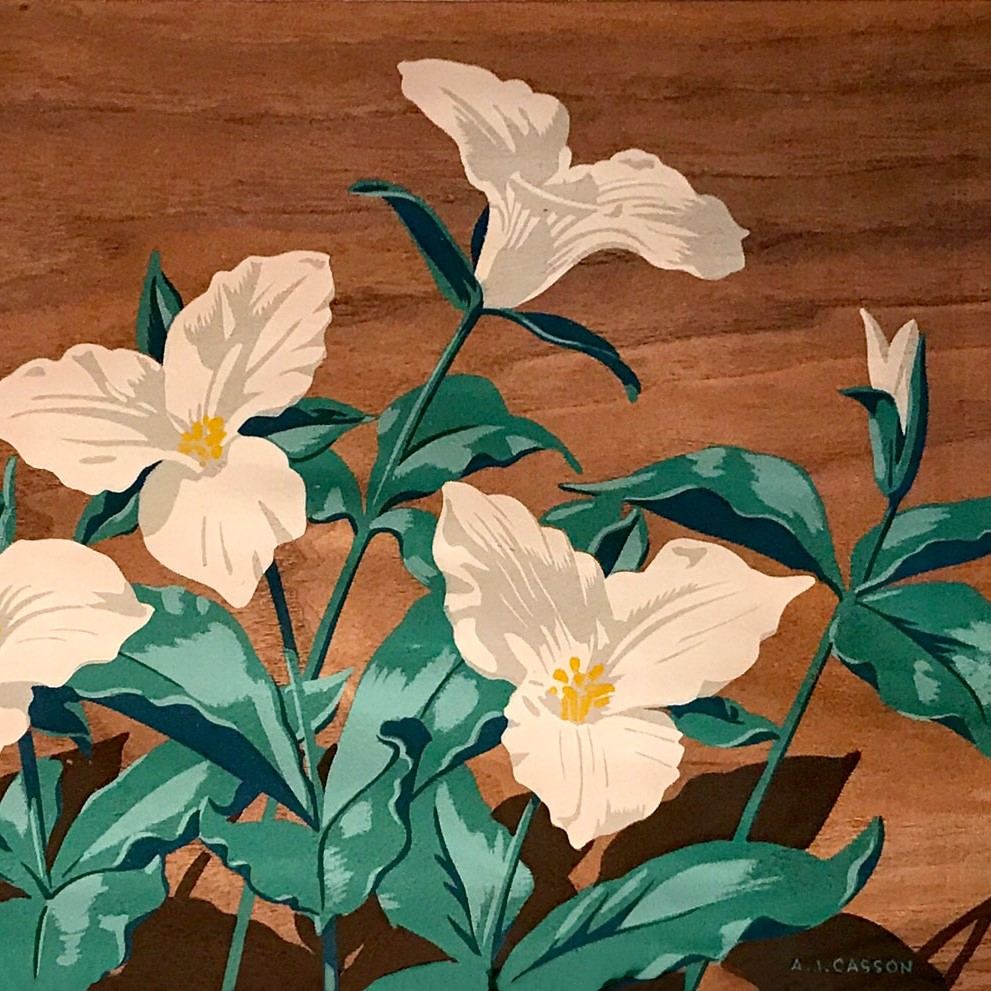A Digital Exhibit of Fine Art by Canadian Artists
A Digital Exhibit of Fine Art by Canadian Artists

A.J. CASSON
Alfred Joseph Casson (1898 – 1992) was the youngest member of the group of Canadian artists known as the Group of Seven. He joined the organization in 1926 at the invitation of Franklin Carmichael. He is best known for his oil, watercolour, and silkscreen depictions of southern Ontario, particularily areas of small villages, farms, forests, and rolling hills of "cottage country", like Lake Kashagawigamog. His interpretation of the subtle variations of summertime green has become a trademark of his work.
Casson was born in Toronto in 1898 to an English Quaker father and a Canadian mother. He and his family moved to Hamilton, Ontario in 1912. His father sent him to work at age 15 as an apprentice at a Hamilton lithography company. In 1915 the family moved back to Toronto. His first public exhibition was at the Canadian National Exhibition, in 1917. In 1919 he began working for the commercial art firm of Rous and Mann in Toronto, where he assisted Group of Seven member Franklin Carmichael. He was encouraged by Carmichael to continue sketching and painting on his own. Casson openly admits his immense debt to Carmichael as a designer and painter. The two then moved on to the first Canadian silkscreen printing firm, Sampson, Matthews Ltd, founded by artist J. E. Sampson and businessman C. A. G. Matthews. Carmichael introduced Casson to The Arts and Letters Club of Toronto, where he met many well-known artists, including other Group of Seven members.
In 1925, along with Carmichael and Fredrick Brigden, Casson founded the Canadian Society of Painters in Water Colour. In 1926, he became an official Group of Seven member, as well as an associate member of the Royal Canadian Academy. He began teaching in 1932 at the Ontario College of Art, and later became their Art Director and Vice-President. He was elected to the National Academy of Design as an Honorary Corresponding member.
When the Group of Seven disbanded in 1932, he co-founded the Canadian Group of Painters, which adopted several of the Group of Seven painters including Lawren Harris, Arthur Lismer, A. Y. Jackson, and Franklin Carmichael.
In 1954 he was one of eighteen Canadian artists commissioned by the Canadian Pacific Railway to paint a mural for the interior of one of the new Park cars entering service on the new Canadian transcontinental train. Each the murals depicted a different national or provincial park; his was Algonquin Provincial Park.
Casson developed a painting style distinctly his own. He represented a pastoral, pioneering Ontario that has since vanished in the face of an urban world. His work has become much loved by the Canadian public, and his accomplishments have been recognized with honours from many organizations. His work reflects the ideals of The Group of Seven, yet it has provided insight into a part of Canada he knew and loved well.
A. J. Casson died in 1992 and is buried on the grounds of the McMichael Canadian Art Collection, along with six other Group of Seven members.

A.J. CASSON
Alfred Joseph Casson (1898 – 1992) was the youngest member of the group of Canadian artists known as the Group of Seven. He joined the organization in 1926 at the invitation of Franklin Carmichael. Casson is best known for his oil, watercolour, and silkscreen depictions of southern Ontario, particularily areas of small villages, farms, forests, and rolling hills of "cottage country", like Lake Kashagawigamog. His interpretation of the subtle variations of summertime green has become a trademark of his work.
Casson was born in Toronto in 1898 to an English Quaker father and a Canadian mother. He and his family moved to Hamilton, Ontario in 1912. His father sent him to work at age 15 as an apprentice at a Hamilton lithography company. In 1915 the family moved back to Toronto. His first public exhibition was at the Canadian National Exhibition, in 1917. In 1919 he began working for the commercial art firm of Rous and Mann in Toronto, where he assisted Group of Seven member Franklin Carmichael. He was encouraged by Carmichael to continue sketching and painting on his own. Casson openly admits his immense debt to Carmichael as a designer and painter. The two then moved on to the first Canadian silkscreen printing firm, Sampson, Matthews Ltd, founded by artist J. E. Sampson and businessman C. A. G. Matthews. Carmichael introduced Casson to The Arts and Letters Club of Toronto, where he met many well-known artists, including other Group of Seven members.
In 1925, along with Carmichael and Fredrick Brigden, Casson founded the Canadian Society of Painters in Water Colour. In 1926, he became an official Group of Seven member, as well as an associate member of the Royal Canadian Academy. He began teaching in 1932 at the Ontario College of Art, and later became their Art Director and Vice-President. He was elected to the National Academy of Design as an Honorary Corresponding member.
When the Group of Seven disbanded in 1932, he co-founded the Canadian Group of Painters, which adopted several of the Group of Seven painters including Lawren Harris, Arthur Lismer, A. Y. Jackson, and Franklin Carmichael.
In 1954 he was one of eighteen Canadian artists commissioned by the Canadian Pacific Railway to paint a mural for the interior of one of the new Park cars entering service on the new Canadian transcontinental train. Each the murals depicted a different national or provincial park; his was Algonquin Provincial Park.
Casson developed a painting style distinctly his own. He represented a pastoral, pioneering Ontario that has since vanished in the face of an urban world. His work has become much loved by the Canadian public, and his accomplishments have been recognized with honours from many organizations. His work reflects the ideals of The Group of Seven, yet it has provided insight into a part of Canada he knew and loved well.
A. J. Casson died in 1992, just three months short of his 94th birthday, and is buried on the grounds of the McMichael Canadian Art Collection, along with six other Group of Seven members.
A Typical Pioneer Homestead in Eastern Canada

Farmhouse in the Hills, Quebec

Goose Lake

Purple Flowers

White Flowers
